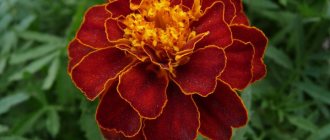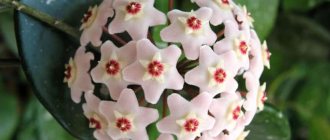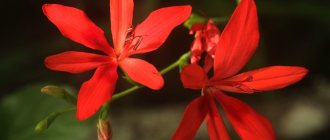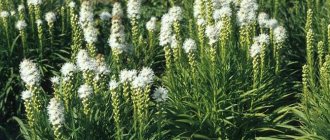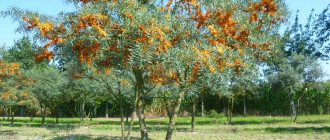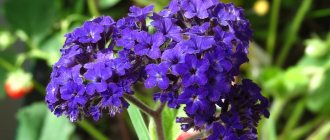In order for the site to be bright and beautiful in early spring, you need to take care of it now, in the fall. After a long winter, bulbous plants are the first to delight with sunny, magnificent flowers. White woods, delicate pushkinias, cheerful crocuses, touching chionodoxes appear right from under the snow... Surprisingly, we can still feel the echoes of winter - it’s freezing at night, snow may still fall, and small thin almost transparent primroses bloom to our delight and withstand harsh conditions early spring. And when the sun warms up more and spring comes into its own, spectacular and powerful hazel grouse, fragrant hyacinths, delicate daffodils and many-sided tulips appear on the land freed from snow and ice.
Many people have known bulbous plants for a long time, while others will be meeting them for the first time.
Who are the “bulbous” ones?
Under the general name “bulbous” there are collected many different plants with a single characteristic: they all reproduce by “bulbs”. The bulb consists of a small bud, which is located in the very center of the plant on an atrophied stem with roots and scales. The bud is surrounded by all the nutrients necessary for life, growth and flowering. Every year, the bulb is renewed from the inside due to new scales displacing the old ones.
Most bulbous bulbs are winter-hardy and unpretentious; once planted, they delight owners with their bright colors every spring, which is what captivates more and more flower growers.
Where to buy bulbs?
You can buy bulbs from flower growers-collectors, in specialized gardening stores or garden centers, in supermarkets, from “grandmothers” or from a neighbor. It all depends on what exactly you want to purchase. It is clear that in order to contact breeders, you must at least really love and have a good understanding of these plants. And if you are a beginner gardener, the “garden supplies” section in the supermarket will be enough for you. Usually there is a fairly diverse selection of good bulbs, which in the spring will turn your plot into a blooming, fragrant meadow.
How to choose healthy bulbous plants?
You don't need to be an expert to distinguish a good quality product from a damaged one. The onion should have a fresh appearance, be dry (but not overdried - such an onion is too light), strong to the touch, without cracks, cuts or dark spots. Small brown or brown spots are allowed. Pay attention to the size. The rule certainly applies here: a big bulb means a big flower. After all, large bulbs contain a larger supply of nutrients, which means the flower will be healthy and attractive.
Don't be alarmed if you see a large hole in the center of the hazel grouse bulb. This is fine. The hazel grouse has a thick peduncle, so after it dies, a deep, sometimes through hole is formed.
Remember that some bulbs are poisonous (for example, colchicum, umbelliferum, hyacinth, snowdrop and scilla), and can therefore be harmful to health. So keep them out of the reach of children and curious animals.
Now there may already be discounts on bulbs - since many gardeners have already closed the season and the time for planting is coming to an end. If the “discounted” bulb is of satisfactory quality, buy without fear and plant until frost. Believe me, the tulip will definitely have enough time to take root and delight you with flowering in the spring.
Ice and fire
This bright composition is for emotional, passionate people. Suitable for a front flower bed in an open, sunny area. The attraction of color and aromas is difficult to overcome - such a flower garden will certainly be the center of attention.
Ice and fire
But it’s not for nothing that they say that beauty requires sacrifice - you will have to take care of such a flower garden: dig up and dry the bulbs in time (except for daffodils, which do not need annual digging), and in September-October plant them again in loose, fertile, well-drained soil. The hyacinths included in the selection require light shelter for the winter.
All plants from this composition are suitable for cutting. They bloom at the end of April - the first half of May, flowering is long.
What's included in the collection:
- Large-crowned narcissus Perfect Lady, bulbs made in Holland, 5 pcs. packaged. Plant height is 40-50 cm.
- Imperial hazel grouse Rubra, made in Holland, 1 bulb per package. Plant height - up to 90 cm.
- Kaufman tulip Heart's Delight, bulbs made in Holland, 8 pcs. packaged. Plant height - up to 25 cm.
- Hyacinth Red Magic, 3 bulbs per pack. The height of the flowering plant is up to 25 cm. Fragrant.
- Early double tulip ABBA, 10 bulbs per package. Plant height 30-35 cm. Fragrant.
- Double hyacinth Snow Crystal, 5 bulbs per pack. The height of the flowering plant is up to 25 cm. Fragrant.
Rules for planting bulbs
Choose a sunny, wind-protected area with fairly fertile, loose and well-drained soil. Scatter mineral fertilizers on the surface, (g/m2): ammonium nitrate - 12, superphosphate - 50, potassium sulfate - 40, and wood ash - 200-300. Then dig the soil to a depth of 20 cm. Add coarse washed sand and humus. By doing this you will achieve not only good air exchange, but also excellent water permeability of the prepared soil. Many bulbous plants need to be planted when the soil temperature drops to plus nine to plus ten degrees. Usually this is October - early November.
Before planting, all the bulbs, even if they seem completely healthy to you, for prevention, it is advisable to place them in a 0.1% solution of potassium permanganate (potassium permanganate) or any fungicide for thirty minutes.
Regarding the planting depth of bulbs, there is a universal rule: the planting depth should be equal to the height of 3 bulbs. This way small bulbs will sit higher than their larger “comrades”. For crocuses this distance is 7-10 cm, for daffodils and hyacinths - 15 cm. Tulips are usually planted at a depth of up to 20 cm.
In the prepared soil, dig a hole of the required depth, pour two to three centimeters of clean sand at the bottom of the hole. And plant onions on this “sand cushion”. Sand prevents pathogenic microorganisms from penetrating into the bottom of the bulbs.
As for the distance between two bulbs, you need to plant based on the size of the adult plant. The larger they are, the farther apart they are. Experts recommend leaving 7-8 cm between large onions and 5 cm between small ones.
There are a few more comments about this: when planting hyacinth bulbs, you need to focus on the weather, the main thing is that the temperature should not be higher than +9C. It is at this temperature that the rooting of this plant occurs successfully. With earlier planting, there is a high risk of death or autumn germination with subsequent frost damage to the hyacinth sprout.
Attention: planting imperial hazel grouse is somewhat different from planting other bulbous plants. Imperial hazel grouse bulbs are planted deep, in those places on the site where the soil warms up well throughout the summer season. Planted when young roots appear on the bulb. A sand mound is poured into a hole about 30 cm deep. The bulb is placed on a sandy mound slightly sideways so that water does not flow into the hole from the peduncle, which can cause rotting, and is covered with earth.
After planting the plant, do not throw away the packaging - save it. Firstly, to simply check what was stated and what grew as a result; secondly, if next season you want to buy more of the same bulbs, you can easily navigate the different names, having before your eyes a package with plants growing on your site.
It happens that the plant did not turn out as luxurious as shown on the packaging or illustration - the wrong color, the wrong size, lack of fullness or flowering at all... There are several reasons for this. First: poor quality of planting material; second: perhaps all agrotechnical conditions for the growth of this plant (planting, soil, light, watering, fertilizing, etc.) were not met; third: the plant is infected with parasites or was sick.
Planting hyacinths step by step instructions
Hydrangea Magical Candle - care and planting of the variety in open ground
1. First of all, you should choose a place for hyacinths. These flowers are quite beautiful and attractive, but low-growing. This must be taken into account when choosing a location: it is advisable not to plant the bulbs where the hyacinths will be in the shade of tall plants. You can perfectly frame a garden bed with hyacinths or make a separate flower bed for these flowers. You can also use a ready-made flowerbed with other plants!
For example, we chose the space around the peony bush. We decided to plant hyacinth bulbs in two rows around the peony. When the plants grow and finally bloom, their combination with peony will look interesting!
So, having chosen a place for the “new ones” in the flowerbed, you should lay out the hyacinth bulbs in front of you and count how many there are. We decided to make a double "rim" of 24 bulbs, so that there were 12 flowers in each row.
We also advise you to choose the amount of planting material that can be planted with the same distance between the bulbs. In other words, it is best to take the number of bulbs that are a multiple of four. You will also need gardening gloves and a tool for digging small but deep holes.
2. Planting hyacinths does not require preliminary soil preparation. Naturally, if you have heavy soil on your site, it is better to dig it up before planting. But no fertilizers are needed: it would be better to feed the plants in the spring. So you can immediately start creating a hole for the bulb. Push the hole-forming tool deep into the ground, at least 10 cm.
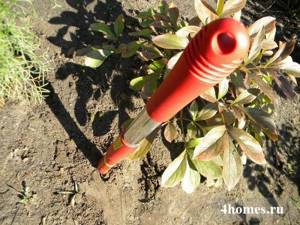
3. Turn the tool in a circle in the direction where its tip is directed. It is difficult for a fragile summer resident to do this (especially in loamy soil), so you will have to take the tool with both hands. After spinning the tool, remove it from the ground, being careful not to scatter the soil stuck in the tool.

4. Now the stage has come when hyacinths can be planted directly into the formed hole. Take the onion and lower it to the very bottom of the hole, placing the tip up. Lightly press the bulb down to anchor it in the soil.
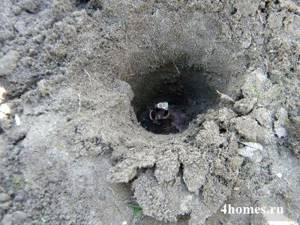
5. Planting hyacinths in open ground ends by filling the hole with soil that you pulled out with the tool. Simply pry up the soil stuck in the tool with your hand and sprinkle it on top of the bulb. There is no need to trample down the soil too much: let the bulb receive more oxygen.
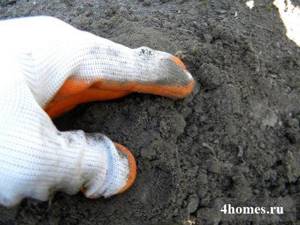
6. One hyacinth is already in the ground! But planting hyacinths requires a whole flower bed, because individually they do not look so impressive. So now plant all the other bulbs in the same way.
If you have a multiple of four bulbs, creating a neat flower bed will not be difficult. First, plant four bulbs, arranging them like the numbers 12, 3, 6 and 9 on a clock face. Then plant two between each two bulbs, approximately calculating the same distance. One row of 12 bulbs is ready!
Now you can plant the second row of flowers, placing the next 12 bulbs, slightly moving them in relation to the first row. The flowerbed will turn out lush and beautiful!
Tips for placing bulbs in a flower garden
First of all, for bulbous plants, you should choose a planting location so that you can admire your flowers. After all, it is the bulbous ones that will decorate the garden during the spring months - after the cold weather they are especially dear to us. In early spring, the craving for beauty is most acutely felt, when during the long gloomy winter we have yearned for bright colors and spectacular forms.
In a small home garden, where, as a rule, there is little free space, early spring bulbous plants can be placed in close proximity to perennials. When the early spring bulbs fade, the unsightly fading tops will be covered by the foliage of growing perennials, such as peonies, ferns or hostas.
If there are no perennials in your flower garden yet, and the foliage of primroses that has lost its decorative effect spoils the appearance of the flower bed, disguise the dying bulbous plants with annual plants. This can be self-grown or purchased seedlings. You can also sow the seeds of unpretentious annuals in advance in the area where the bulbs grow. At the end of May - beginning of June, the flyers will already have gained good growth. Marigolds, nasturtium, escholshiya, godetia, petunia, matthiola and other flowers will perfectly decorate faded early spring bulbous flowers.
Low-growing crocuses, snowdrops, and pushkinias bloom first. Their flowers are located almost on the surface of the earth. In order to be able to see the charming crumbs up close, they should be planted on the edge of flower beds, near paths and paths. Daffodils and tulips, which have large flowers and later flowering periods, can be placed in the background and middle ground of flower beds and in remote corners of the garden. Plant hyacinths and muscari, which give a surprisingly delicate aroma, near the bench and under the windows.
For greater decorativeness, small bulbous plants are planted in groups of 8-10 or more pieces. White snowdrops, pushkinias, purple, lilac, yellow crocuses planted in small groups look very impressive. If you choose a place for planting where the snow melts first, the primroses will bloom early. In order for the plants to bloom at the same time in the spring and have the same height, it is necessary to form a group of bulbs of approximately the same size. Then the flower island will look most neat and impressive.
You don’t have to dig up tulips for two to three years, and daffodils for up to five years. Small-bulbous plants, once planted, can no longer be disturbed at all. Over time, growing in width, they form bright picturesque spots. But in this case, do not forget to somehow (with a flag, a label) mark the places where the bulbs are planted even before the above-ground part of the plants dies. Otherwise, in the fall, when digging the soil, you can damage the dormant bulbs.
When planting bulbs on a lawn or under trees, they are placed so that groups of flowers look natural and appear to be growing wild. In practice, the planting technology is as follows: pour out the bulbs from the palm of your hand near the tree, where the bulb fell - and plant it there. This way you will achieve maximum naturalness of the fit.
Options for spring flower beds
In the event that you plan to place a flower garden in the partial shade of garden trees or shrubs, take bergenia, daffodils, lilies of the valley and brunner.
Lilies of the valley, charming and sophisticated, with a unique aroma, are planted taking into account the fact that their root system tends to take deep roots. Therefore, their plantings should be limited in growth and placed in the shade at a sufficient distance from other plants. This way you will provide them with a longer flowering period. Nowadays, breeders have created many varieties of these plants adapted to garden culture in colors ranging from white to soft pink, with large flowers.
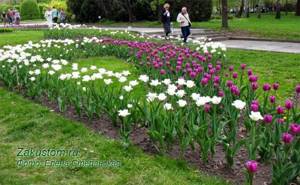
Daffodils, hyacinths and tulips can be planted in continuous plantings in the form of strips, borders, arrays, and parterres. In this case, the bulbs are planted so densely that when they bloom, a lawn of plants of the same type or a carpet in the form of an ornament of plants of different varieties and colors is formed.
The combination of tulips with daffodils, muscari and hyacinths looks good. Such flower beds most often decorate our streets and parks. At the end of flowering, the bulbous plants must be dug up and transplanted into spare beds or special containers in order to allow the plants to complete the growing season.
Rock gardens occupy a special place in landscape design. Such plantings can provide flowering plants from early spring to late autumn.
In order to create an alpine meadow or hill, they take as ground cover plants - awl-shaped phlox, evergreen iberis, rock alyssum, spreading arabis, saxifrage, primrose, corydalis. As beautifully flowering ones, they take special low-growing varieties with small flowers of crocuses, scillas, hyacinths, muscari, chionodoxes, galanthus, daffodils, pushkinias, and tulips.
In spring...
The only thing bulbs need in the spring is watering. And then only if the spring is dry. As soon as the plants begin to bloom, it is necessary, as with any flower crop, to remove the faded inflorescences. This way the flower garden will have a well-groomed appearance, and the plants will not lose strength to form seeds. Remember: no matter how much you want, yellowed leaves cannot be removed; they must die off on their own, without intervention. This way the plant will be able to fully restore the bulb, which means it will delight you with lush flowering next season.
Photo: Olga Dumkina
Caring for daffodils in the open ground
The short life span of bulbous ornamental crops explains the compact schedule of activities for caring for daffodils in the open ground.
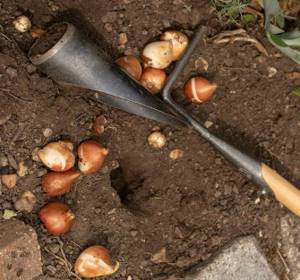
In the spring, when the snow has not yet melted, urea is scattered so that the necessary nitrogen reaches the awakening plants with the melt water.
If the area was covered with sawdust to preserve the bulbs from frost, then such mulch is removed before the flower leaves appear.
The hot sun quickly dries out the top layers of soil, so the first watering in the garden plot is the flower bed with daffodils. Lightly loosen the soil so that air can more easily reach the bulbs. In addition, air circulation reduces the risk of daffodil fly attacks.
As soon as the leaves turn green, mulch from compost or humus is laid around the plants.
Tender plants absolutely do not tolerate fresh manure.
If there are no organic fertilizers, a complex mineral fertilizer is applied with an emphasis on nitrogen in the first days and with a high content of potassium and phosphorus before bud formation and flowering.
Care after flowering
The duration of flowering depends on the specific variety and weather conditions, but rarely exceeds 3 weeks. As soon as the beauty has faded, all flower stalks are removed: they easily break off near the ground.
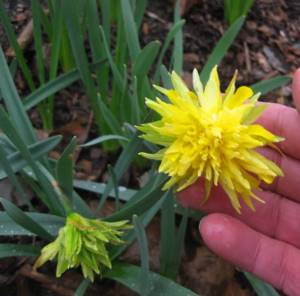
The plant no longer needs this part, but the leaves should not be touched until they dry completely.
This is the only above-ground part of the narcissus that is necessary during the period of laying nutrients in the bulb, which is preparing to bear children and prepare for wintering.
If fresh daffodils are cut off, the transitional-preparatory process will be interrupted: such a bulb may not survive the winter as a result of improper care after flowering.
Only after the aboveground part has withered, when the dormant period begins, the leaves are cut off, the bulbs are dug up, inspected, and sorted.
Before planting, place in a warm place, but not more than 25°C.
The main condition is good ventilation.
If winter forcing is planned, then the dried and ventilated bulbs are stored in the cellar (they are dropped into moistened sand) or in the refrigerator.
Winter storage
Daffodils are usually designated for winter storage in a cellar or refrigerator either if the variety is heat-loving or for forcing.
To preserve planting material before planting, the moisture content of the substrate is controlled in the cellar, and ventilation is controlled in the refrigerator. Occasionally, the bulbs are sorted in order to immediately isolate diseased, rotten specimens.
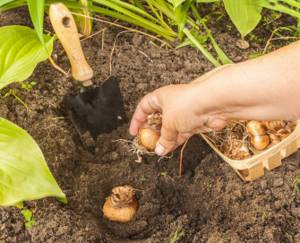
For forcing, daffodils are planted in small pots or containers so that the bulb rises at least a third above the ground.
The planting is dense, without gaps, the soil is loose, moisture-absorbing (3 hours of peat + 1 hour of sand).
15-20 days before the required flowering period, the container is taken out of the cold into light and into heat up to 12-15°C.
This regime depletes the plant; in the spring, daffodils are transplanted from the pot into open ground without the expectation of flowering. These specimens are suitable for re-forcing no earlier than after 3 years.
What to do to make daffodils bloom every year
For annual flowering, a full dormant period with low temperatures and adherence to agricultural techniques for growing bulbous ornamental crops are required.
Violation of the rules of planting and care, premature pruning of foliage, unsuitable soil - any factor discussed in the article is determining.
Is it possible to replant flowering daffodils?
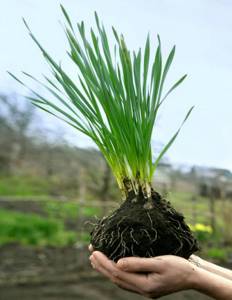
A rare plant will survive transplantation during flowering without loss.
If circumstances force the transfer of daffodils to another place before the buds wither, it is better to cut off the flower stalks at the root so that it is easier for the flower to take root in a new place.
Additional help will be treating the bottom with root formation stimulants.
A plant transplanted during an unfavorable period requires attention - the soil should not be allowed to dry out until rooting is complete.
